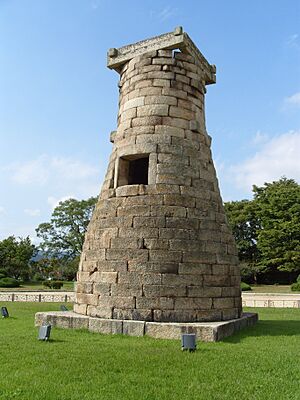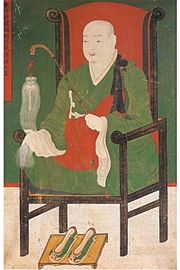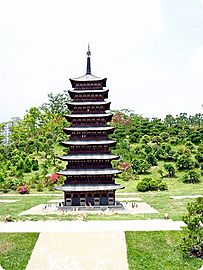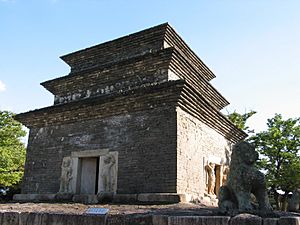Queen Seondeok of Silla facts for kids
Quick facts for kids Queen Seondeok善德王 선덕왕 |
|||||||||
|---|---|---|---|---|---|---|---|---|---|
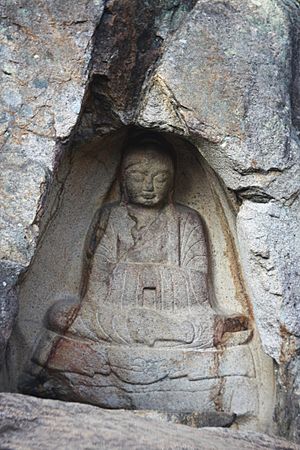
This statue is sometimes said to be a model of Queen Seondeok.
|
|||||||||
| Queen of Silla | |||||||||
| Reign | 632–647 (15 years) | ||||||||
| Coronation | 632 | ||||||||
| Predecessor | Jinpyeong of Silla | ||||||||
| Successor | Jindeok of Silla | ||||||||
| Born | c. 595~610 | ||||||||
| Died | February 17, 647/January 8, Lunar Calendar Silla |
||||||||
| Burial | Seondeogyeowangneung, Gyeongju-si, South Korea | ||||||||
|
|||||||||
| Father | Jinpyeong of Silla | ||||||||
| Mother | Queen Maya of Silla | ||||||||
| Queen Seondeok of Silla | |
| Hunminjeongeum |
선덕여왕, also 선덕왕
|
|---|---|
| Hanja |
善德女王, also 善德王
|
| Revised Romanization | Seondeok yeowang, also Seondeok wang |
| McCune–Reischauer | Sŏndŏk yŏwang, also Sŏndŏk wang |
Queen Seondeok of Silla (Korean: 선덕여왕; c. 595~610 – 17 February 647) was the first reigning queen of Silla. Silla was one of the Three Kingdoms of Korea. She ruled from 632 to 647. She was the twenty-seventh ruler of Silla.
Queen Seondeok was the second female ruler in East Asian history. She helped bring new ideas, literature, and art to Silla. People described her as "generous, kind, wise, and smart." Some legends even say she was very beautiful.
Contents
Becoming Queen: How Seondeok Took the Throne
Princess Deokman was the daughter of King Jinpyeong and Queen Maya of Silla. She had two sisters, Princess Cheonmyeong and Princess Seonhwa. It's not fully clear if she was the oldest daughter.
King Jinpyeong had no sons to become king. So, Princess Deokman asked for a chance to rule. Women in Silla already had some power. But having a queen on the throne was still new. Princess Deokman worked hard to show she was worthy. She gained the trust of her people. She was then chosen as King Jinpyeong's successor.
Not everyone agreed with this decision. Some officials planned a rebellion in 631. They wanted to stop her from becoming queen. But their plan was found out quickly. The leaders were caught and executed. This showed that Queen Seondeok was determined to rule.
Queen Seondeok's Reign: Leading Silla
In January 632, Queen Seondeok became the first queen of Silla. Her main goal was to help her people. She sent royal inspectors across the kingdom. They made sure that widows, orphans, and the poor were cared for.
She also sent a diplomat to China's Tang dynasty. She wanted to tell them about Silla's new queen. However, Emperor Taizong of Tang did not want a woman to rule. He refused to accept her as a queen. But Queen Seondeok did not let this bother her. Korean rulers often saw themselves as equal to Chinese emperors.
Building for the Future
In her second year, Queen Seondeok built Cheomseongdae. This was an observatory to study the stars. It helped farmers know when to plant and harvest. She also removed taxes for peasants for a whole year. She lowered taxes for the middle class too. These actions made her popular with the people. This helped her gain more support.
Challenges and Wisdom
Silla faced many attacks during her reign. Uija of Baekje attacked Silla in 642. He took many fortresses. Baekje and Goguryeo also blocked a sea route to China. Queen Seondeok asked the Tang Emperor for help. He offered to send a male Tang royal to be Silla's new king. He thought Silla's enemies did not fear a female ruler. Queen Seondeok refused this idea.
During this difficult time, Queen Seondeok asked for advice from a monk named Jajang. He suggested building a huge nine-story pagoda. This pagoda would help protect Silla from invasions. It would also calm the people. The queen agreed, even though it would cost a lot. She told her officials to use her palace materials if needed. After two years, the Hwangnyongsa pagoda was finished. It was the tallest temple in East Asia.
Queen Seondeok also started the plan to unite the Three Kingdoms. She formed an alliance with the Tang dynasty. This alliance helped Silla against Baekje and Goguryeo.
Bidam's Rebellion: A Final Challenge
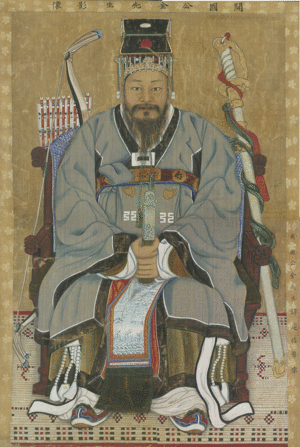
In 647, Queen Seondeok faced a big challenge. Some of her top officials started a rebellion. They were led by Bidam. He said that "The female king failed to rule the country." Bidam had a lot of power. This made it the biggest rebellion in Silla's history.
A famous story tells how the rebellion was stopped. A star fell near the queen's home. Bidam said this was a sign that the queen would fall. Queen Seondeok was worried. But Gim Yu-sin calmed her. He flew a large kite with a burning scarecrow. It looked like the star was back in the sky. Bidam's followers lost hope.
The rebellion lasted less than 10 days. It was stopped by Gim Yu-sin and Kim Alcheon. Bidam and his followers were executed.
The Queen's Passing
Queen Seondeok died on February 17, 647. This was shortly after Bidam's rebellion was put down. The exact cause of her death is not known. She had been ill before she died. Some think she might have died from the shock of the rebellion. She was buried in a tomb on Nangsan Mountain. After her death, her cousin, Queen Jindeok, became the next queen of Silla.
Buddhism and Astrology: Queen Seondeok's Interests
Like her father, Queen Seondeok was very interested in Buddhism. Many temples, pagodas, and Buddha statues were built during her rule. The Hwangnyongsa temple was one of the most famous. It was built to protect the country. It also showed the wish to unite the three kingdoms. The queen often prayed there for wisdom.
Other temples like Bunhwangsa and Tongdosa were also built. She also built the Cheomseongdae "Star-Gazing Tower." This was the first observatory in the Far East. It helped farmers and still stands today in Gyeongju.
Queen Seondeok's Marriages
Some historical texts say Queen Seondeok had three husbands. These were Kim Yongchun, Ulje, and Lord Heumbahn. Another text says she married Galmunwang Eum.
However, many believe she never married. This was likely to avoid political problems. The queens who ruled after her, Queen Jindeok and Queen Jinseong, also did not marry.
Legends of Queen Seondeok
Queen Seondeok was known for her wisdom. Many legends tell stories about her insights.
The Peony Flowers and Her Wisdom
The Emperor of China once sent Queen Seondeok a painting of peony flowers. He also sent their seeds. The queen had the seeds planted. But she said, "Even though the flower is pretty, it probably doesn't smell much." When the flowers bloomed, they had no scent.
People were surprised she knew this. She explained that the painting showed no butterflies or bees. This meant the flowers had no fragrance. She also said the Emperor was making fun of her for not having a husband. Peonies with no scent were like a woman without a husband. It is said that the temple Bunhwangsa (meaning "Fragrance of the Royal Temple") was built as a response to this.
The Legend of Jigwi
This is a story about a man named Jigwi. He fell deeply in love with Queen Seondeok. He stopped eating and sleeping, only calling her name. One day, the queen visited a temple. Jigwi followed her. The queen felt sorry for him. She left her bracelet on his chest while he slept.
When Jigwi woke up and saw the bracelet, he was so happy. His love for the queen was so strong that his body turned into fire. The fire burned down a pagoda and Jigwi himself. Some say he burned himself to show his burning passion.
Croaking Frogs and the Jade Gate
One winter day, frogs gathered at a pond called Okmun ("Jade Gate"). They croaked loudly for days. When the queen heard this, she immediately sent her generals. She told them to go to a valley called Yeogeungok ("Cradle of Life"). She said an enemy army would be waiting there.
Her generals found 500 Baekje soldiers hiding there. They defeated them. The queen explained her wisdom: "Angry frogs mean an army. Jade Gate means a woman's purity. Woman is linked to 'Yin,' which also means white and the West. So, I knew an army was in the West. The valley's name, 'Cradle of Life,' meant they would be easy to defeat." This showed her deep understanding of Yin and Yang philosophy.
Her Burial Place
Before she died, Queen Seondeok told her officials where to bury her. She wanted to be buried near the Doricheon. This is a level of Heaven in Buddhism. When asked where it was, she pointed to the south side of Mt. Namsan.
Years later, King Munmu of Silla built a temple called Sacheonwang-sa near her tomb. People then realized that a Buddhist saying was true: "Doricheon is above the Sacheonwang-cheon." Some historians think this was her wish to be reborn as a man. She had faced many challenges as a female ruler.
Family
- Father: King Jinpyeong (567–632)
- Mother: Kim Bokhilgu, Lady Maya
- Siblings:
- Princess Cheonmyeong
- Kim Chun-chu (604–661), who later became King Muyeol.
- Princess Seonhwa (her existence is debated)
- Princess Cheonmyeong
- Cousin: Kim Seung-man, who later became Queen Jindeok.
In Pop Culture
Queen Seondeok's story has been told in many modern ways:
- She was played by Lee Ae-jung in the 2005 TV series Jump.
- She appeared in the 2006-2007 SBS TV series Yeon Gaesomun.
- Lee Yo-won and Nam Ji-hyun played her in the popular 2009 MBC TV series Queen Seondeok.
- Yoon So Yi played her in the 2011 film The Bracelet of Blue Tears.
- She was featured in the 2012–2013 KBS1 TV series Dream of the Emperor.
- Seondeok is a leader for the Korean civilization in the video game Civilization VI.
- She is a playable character in the mobile game Rise of Kingdoms.
- She is a character in Sheri Holman's book Sondok: Princess of the Moon and Stars.
- She appeared in the 2017 KBS TV series Chronicles of Korea.
- She is a playable hero in the online game Art of War.
See also
 In Spanish: Seondeok de Silla para niños
In Spanish: Seondeok de Silla para niños
- Three Kingdoms of Korea
- History of Korea
- Rulers of Korea
- Queen Seondeok (TV series)
- Sondok: Princess of the Moon and Stars (Korea, 595 A.D.)


